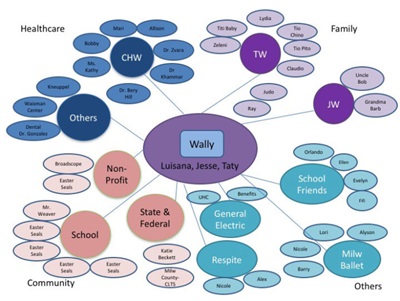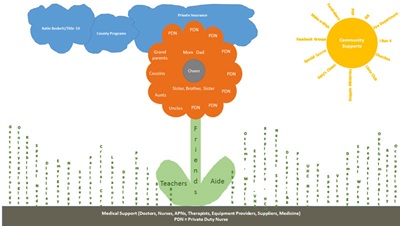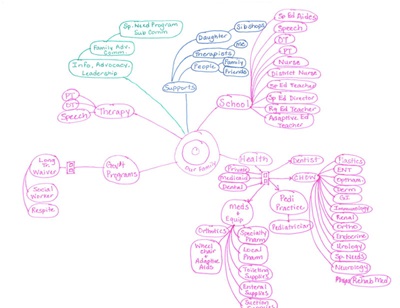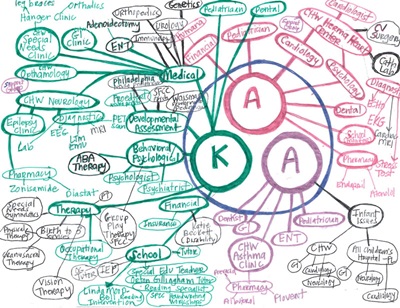For parents of children with special health care needs, telling the story of their child’s care takes more than a thousand, or even tens of thousands of words. The web of care that supports their child is multi-layered and complex.
But drawing a picture puts it in perspective.
A care map is a visual depiction of a child’s health journey, with each map beginning with a circle in the middle representing the child, and radiating out to include health care providers, community support, school resources and more.
Recently, through the Children’s Wisconsin Family Advisory Committee, families had the opportunity to create and share their own care maps. The results are complex, colorful representations that vary as widely as children themselves. “These maps help families take a step back and take a look at the journey they’ve been on,” said Lori Albers, family engagement coordinator at Children’s Wisconsin.
Care maps also help doctors understand patients better. “One family we worked with had 75 providers involved in their child’s care,” said Albers. “Some families are using the maps with doctors to help them understand the family’s journey, others share them with their children’s schools. We’ve even had families show them to lawmakers in Madison as they advocate for health care reform.”
The concept of care mapping was developed by a parent of a child with special health needs, and has since spread nationwide to help families and providers articulate and understand a patient’s health care journey. But for Jesse Waukau of Milwaukee, father of 7-year-old Wally, creating a care map was transformative.
One family’s epiphany
Wally lives with his dad, his mom, Luisana, and his sister. He also lives with cerebral palsy due to complications at birth. “At first, we were just making sure Wally was going to be around,” said Jesse. “Then, once we discovered how resilient he was, we started asking ourselves ‘What can we expect?’ We decided we were going to push Wally as far as we could, and use as many resources as possible.”
The Waukaus built a wide network of support for Wally, and they had soon expanded their circle of care to include not only grandparents, friends and family, but physical therapists, school therapists and community support.
Wally’s family participated in the care mapping exercise alongside other families from Children’s Wisconsin. It was an eye-opener. “When you’re on a disability journey with your child, there are lots of meandering paths. Care can also feel disconnected — he gets his school services, his physical therapy and sees his doctors.” Completing the care map made Jesse and Luisana realize how much time Wally was spending at therapy appointments, or traveling to and from them. “We started asking ourselves how that was impacting our family.”
Wally’s care map

In the end, Wally’s parents decided to decrease his therapy appointments, knowing he was receiving physical therapy in the school setting. “We realized we were focusing too much on Wally’s physical limitations, and not enough on his strengths.” They increased Wally’s community involvement through respite and community care. “Now he’s spending more time experiencing life, going to family cookouts, exploring the community.” Wally is thrilled with the change, and is excited every day before it’s time for his community care. “He loves it,” said Jesse.
Putting it in perspective
Making a care map also helped the Waukaus put Wally’s care in perspective for his grandparents, caregivers and doctors. “Sharing the care map with Wally’s grandparents was great. It helped solidify their importance as a resource, to show them ‘this is what we look to you for.’ I’m hoping they felt that appreciation.”
Jesse and Luisana use the map to anchor them, but also to look to the future. “We’re using it strategically now, thinking about how each individual can help him at the right time,” said Jesse.
Tool for reflection
The Waukaus realize Wally’s care needs are constantly changing. “We’re already planning to revisit his care map. It helps us look at how he’s developing, where the care gaps are, and we may need to look for new resources.”
Jesse encourages any family with a child with special health care needs to make a care map. “It really doesn’t take much time at all,” he said, “and it really opened our eyes.”
Many families’ voices
Owen’s care map

Eight-year-old Owen lives with brain injuries caused by an accident. “A large part of our care journey has little to do with doctors, and is influenced more by day-to-day experiences and growth. We don’t know what tomorrow will hold, so it’s important to ask what matters most today.”
Olivia’s care map

Olivia needs multi-level care for a rare chromosomal disorder “No matter how complicated her care map may be, her doctors work together to ensure that all our medical needs are met,” says Olivia’s mom.
“I’m managing everything, but to see it all on one page and see how complicated it truly is was pretty overwhelming for me. But no matter how complicated her medical issues are, she’s still my daughter who is a pretty amazing child.”
AKA family care map

Kathryn and her two sisters all see specialists at Children’s Wisconsin for various complex health care needs, including heart problems, asthma and neurological issues. “The care map reinforced for us that over-scheduling of community based services and at-home exercises to improve skill deficits may have a negative impact on the entire family,” says her mom. “Children need time to play and develop friendships.”







